Article
Keratoconus progression: Looking beyond Kmax
Author(s):
CXL has potential to alter disease course; progression display plays role in when to intervene

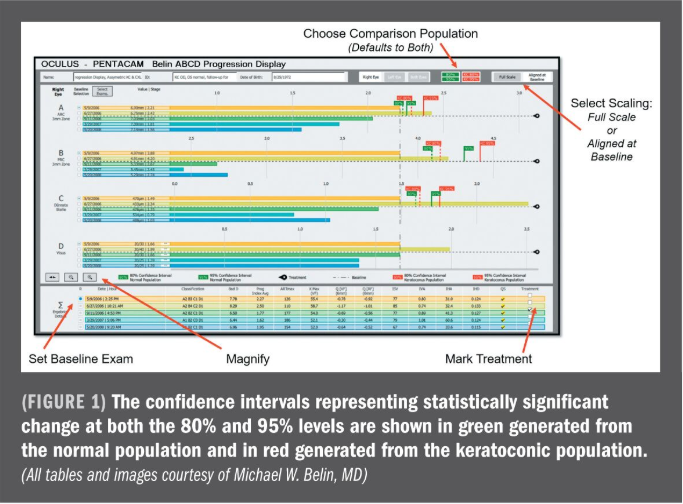
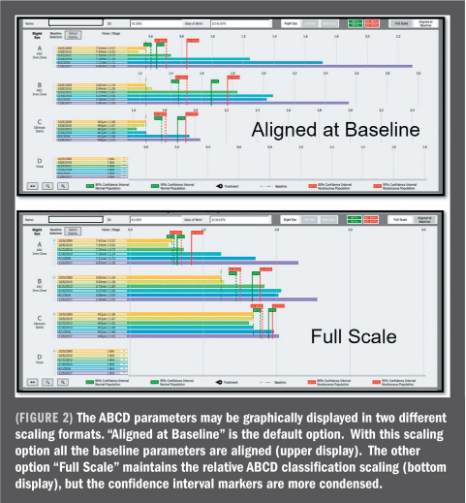
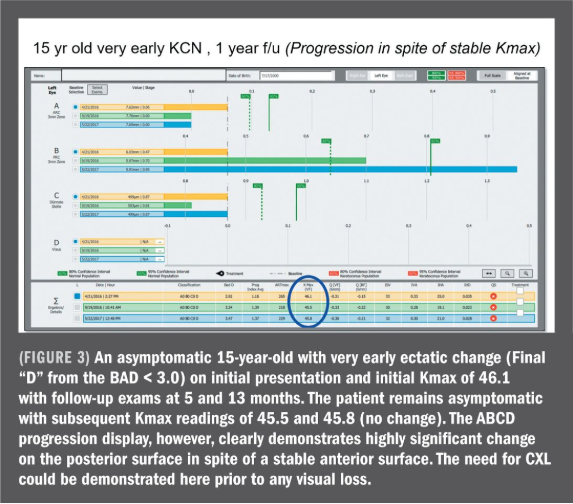
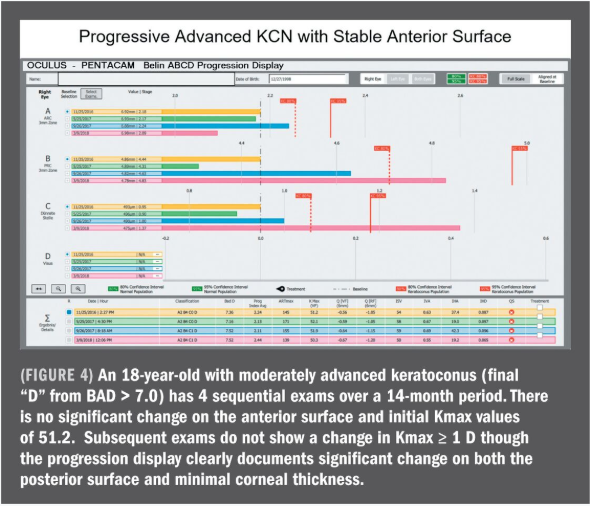
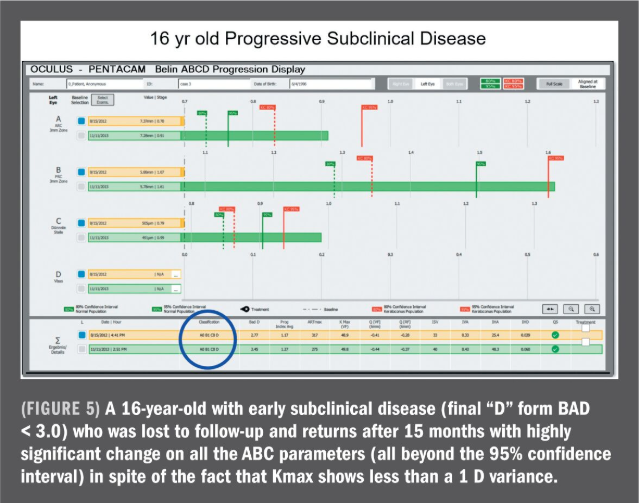
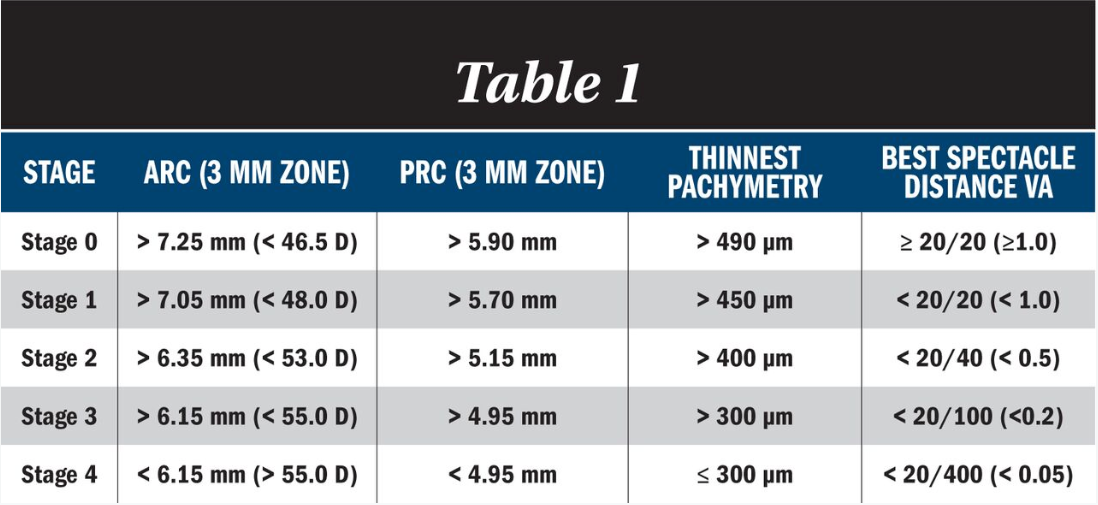
The Belin ABCD Progression Display can provide additional information to assist both surgeon/patient in determining the proper time to intervene in keratoconus.
Corneal collagen crosslinking (CXL) offers the opportunity to slow, stabilize, or even partially reverse what has been a chronically progressive disease in keratoconus. Though CXL has been available for more than a decade outside the United States, its usage within America is still, to some degree, in its infancy.
Adaption of this treatment modality has been hampered by both the expense and the lack of appropriate insurance coverage. When covered, however, many insurance carriers require documentation of further progression using the parameters from the FDA CXL trials.
The most commonly used progression parameter is an increase in Kmax of 1 D or more. Parameters used in FDA trials are just that, and are not meant to set or establish a standard of care, let alone used limit access to care.
An abnormal anterior surface with an elevated Kmax already implies some degree of visual compromise. A further increase in Kmax, as required by many carriers, is typically associated with a further reduction in visual function.
This is contrary to our normal practice of medicine. When we identify a patient with elevated serum cholesterol levels, we empirically start the patient on a statin. We do not wait until they have an occlusive event.
Yet, frequently, our current approach to keratoconus is to intervene only after the patient has already lost vision. This is secondary to both a late diagnosis and the mandate that anterior surface parameters, such as Kmax, must change before carriers will cover the cost of CXL. A few years ago, we introduced a new classification system (Table 1) on the OCULUS Pentacam, the Belin ABCD Keratoconus Staging, to replace the grossly outdated, but commonly used, Amsler-Krumeich Classification.
The benefit of the new system was its recognition of both corneal surfaces and readings centered on the thinnest point of the cornea, as opposed to apical readings that have been used in the past.
The ABCD classification uses the anterior (A) and posterior (B for back) radius of curvature taken from a 3-mm optical zone centered on the thinnest point, the thinnest corneal thickness (C), and distance visual acuity (D) (Table 1). The same parameters can be used to determine when statistically significant progression occurs.
To use these parameters to determine progression, we first had to determine the measurement noise levels associated with each parameter. One-sided confidence intervals were calculated using both a normal and keratoconic population.
It was important to measure both populations since very early or subclinical disease more likely mimics the normal population noise, while more advanced disease with anterior surface changes should more closely follow the keratoconic population.
One-sided confidence intervals at both the 80% and 95% levels were determined (Table 2 on Page 8). The Belin ABCD Progression Display graphically displays the three machine-generated parameters (A, B, and C) and the single-user entered D parameter over time.
In addition, it displays in tabular format at the bottom of the display 11 supplementary parameters including; ABCD classification, overall BAD reading, progression index, ARTmax, Kmax, Q values, ISV, IVA, IHA, and IHD. Up to 8 individual exams can be displayed.
The baseline exam defaults to the oldest exam, but any exam can be set as baseline for comparison purposes by the operator. Treatment date is user selected and displayed by the horizontal hatched line.
The confidence intervals representing statistically significant change at both the 80% and 95% levels are shown in green generated from the normal population and in red generated from the keratoconic population. The confidence intervals are not displayed post-treatment date (Figure 1 on Page 10).
The ABCD parameters may be graphically displayed in two different scaling formats. “Aligned at Baseline” is the default option. With this scaling option all the baseline parameters are aligned (upper display, Figure 2 on Page 10).
The benefit of this scaling is that it increases the separation of the confidence interval markers making it somewhat easier to visual determine progression, but you lose the relative ABCD grading.
The other option “Full Scale” maintains the relative ABCD classification scaling (bottom display, Figure 2 on Page 10), but the confidence interval markers are more condensed. There is also a magnification tool that will allow easier visual determination if needed.
Right time to intervene?
Keratoconus is a progressive disease with serious and often irreversible visual sequelae. Past treatments were for late disease and typically never returned the patient to normal visual function.
CXL has the potential to alter the natural course of the disease and, if implemented early enough in the disease process, to prevent visual loss. Past diagnostic criteria and progression determinants were inadequate to identify the disease and its progression in the earliest stages.
The Belin ABCD Progression Display can provide additional information to assist both the surgeon and patient in determining the proper time to intervene.
Disclosures:
Michael W. Belin, MD
E: mwbelin@eyes.arizona.edu
Dr. Belin is professor of ophthalmology and vision science, University of Arizona, Tucson. He serves as a consultant to Avedro, CXLO, and OCULUS Optikgeräte GmbH
References:
1. Belin MW, Duncan J. Keratoconus: The ABCD Grading System. Klin Monbl Augenheilkd. 2016;233:701-707
2. Duncan JK, Belin MW, Borgstrom M. Assessing progression of keratoconus: Novel tomographic determinants. Eye Vis (Lond). 2016;11:3-6.
3. Belin MW, Meyer JJ, Duncan JK, Gelman R, Borgstrom M, Ambrosio R. Assessing progression of keratoconus and crosslinking efficacy: The Belin ABCD Progression Display. Int J Kerat Ect Cor Dis. 2017;6:1-10.
4. Belin NW, Lim L, Rajpal RK et. al. Corneal Cross-Linking: Current USA Status – Corneal Society Guidance Document. Cornea. 2018;37:1218–1225.
Newsletter
Don’t miss out—get Ophthalmology Times updates on the latest clinical advancements and expert interviews, straight to your inbox.




